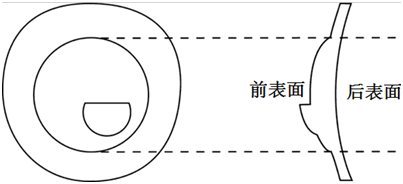高正值度数(无晶状体)镜片设计
作者:GREGORY L. STEPHENS and JOHN K. DAVIS
译者: Lisa Huang
原文出处:http://www.eyecalcs.com/DWAN/pages/v1/v1c051b.html#ato
由于人工晶体的成功,主要为无晶状体人群配戴的高正值度数镜片在眼镜行业的地位被降低了。已经有很多年没有新的无晶状体镜片设计出现了,现有的设计已经可以解决离轴成像,重量,和放大上出现的问题了。非球面无晶状体镜片必须要有大量的基弯选择。
球面镜片中,如果度数大于+7.00D左右,镜片的离轴像散就无法得到矫正,因此所有无晶状体镜片的前表面必须是非球面的。球面或atoric后表面可以提供适当的折射矫正。基弯通常被定义为前表面中心的弯度或度数。大部分无晶状体镜片设计会使用相对较平的基弯,使得后表面较浅。举个例子,典型的+12.00-D的镜片也许有一个+15.00D的基弯,和一个大约为-3.00D的后表面度数。某些设计得到的后表面甚至会接近全平。
设计良好的无晶状体镜片比传统镜片有更多的基弯间隔,因为镜片像散会随着度数的改变而快速改变。基弯间隔应永远不超过1.00D。特别是对于凹面比-3.00D更平的镜片,0.50D的基弯间隔会更好。这个要求只有对于非晶状体镜片来说才特别重要。度数较低的镜片对基弯改变不会那么敏感,如果配戴距离和基弯选择有仔细对照过,1.00D的基弯间隔是可以接受的。
正如低度数非球面镜片中一样,基弯较平的非球面无晶状体镜片设计也会减轻镜片的重量,减少厚度和放大率。合适的非球面前表面可以矫正离轴像散。如果装配师将眼镜调试的离眼睛尽可能近,放大效果也会进一步被减小。小小的圆形镜架可以把镜片重量和厚度控制在最小。
由于考虑到重量因素,几乎所有的无晶状体镜片都是用CR-39塑料制成的。高指数塑料材质的使用可以进一步降低重量和厚度,但是这些材料并未得到使用,因为它们会产生大量的横向色差。
为了获得最好的离轴像,无晶状体镜片的光学中心应位于非球面前表面的极点(转动中心)。同样,如果镜片光轴穿过眼球转动中心,离轴像也会获得最好效果。但是,由于非球面的极点和双焦面在前表面的位置是固定的,通常情况下,在双焦面垂直方向上移动镜片光学中心来马上满足这两个要求是不可能的。相反,光学实验室将光学中心适当地定位在镜片上,然后配镜师应根据光学中心的位置,来调试镜架的前倾角度。如果要让患者获得尽可能好的视觉效果,眼镜诊所就要非常仔细地装配无晶状体镜片。
无晶状体眼镜大致上有三种形式。凸透镜无晶状体镜片(图16)的外形如同一只煎蛋。中间的碗状,即镜片的光学有效部分,直径通常为40mm,且前表面为非球面。外围载体没有光学作用,但是可以通过减小碗状部分的大小来减小镜片厚度。

|
图16为凸透镜无晶状体镜片的主视图和横截面图。 |
全场无晶状体镜片的前表面为非球面,但是外观看起来类似于传统非凸透镜镜片。这些镜片中的一些越靠近边缘越平坦,以至于弧度实际上趋于负值,使镜片看起来像是一块“混合的透镜”。全场镜片一般比凸透镜镜片要厚,但他们配戴起来更好看,也更常用。
无晶状体镜片的双焦面要么是圆的,要么是D形。人们有时更喜欢圆形的双焦面,因为双焦面顶部基底向下的棱镜效果会中和一些镜片其他较远部分的基底向上的棱镜效果,从而达到比D形双焦面更好的光学效果。而且,实验室在布局的过程中,圆形的双焦面镜片毛坯可以绕着非球面极点旋转,从而获得与患者近视瞳距相匹配的双焦面偏心。两种双焦面都足够满足近视的需要。
参考文献
1. Schwartz JT, Ogle KN: The depth of focus of the eye. Arch Ophthalmol 61:578, 1959
2. Campbell FW: The depth of field of the human eye. Optica Acta 4:157, 1957
3. Peters HB: The relationship between refractive error and visual acuity at three age levels. Am J Optom Arch Am Acad Optom 38:194, 1961
4. Sloan LL: Measurement of visual acuity: A critical review. Arch Ophthalmol 45:704, 1951
5. Allen MJ: Vision and Highway Safety, p 56. Philadelphia: Chilton, 1970
6. Davis JK: Prescribing for visibility. Probl Optom 2:131, 1990
7. Richards OW: Vision at levels of night road illumination: XII. Change of acuity and contrast sensitivity with age. Am J Optom Arch Am Acad Optom 43:313, 1966
8. Pitts DG: The effects of aging on selected visual functions: Dark adaptation, visual acuity, stereopsis, and brightness contrast. In Sekuler R, Kline D, Dismukes K (eds): Aging and Human Visual Function, pp 131–159. New York: Alan R Liss, 1982
9. American National Standard for Ophthalmics-Prescription Ophthalmic Lenses-Recommendations. ANSI Z80.1-1995. New York: American National Standards Institute, 1995
10. Owens DA: The resting state of the eyes. Am Scientist 72:378, 1984
11. Tunnacliffe AH, Hirst JG: Optics, pp 178–213. 2nd ed. London: Association of British Dispensing Opticians, 1996
12. Fannin TE, Grosvenor T: Clinical Optics, pp 134–141. 2nd ed. Boston: Butterworth-Heinemann, 1996
13. Atchison DA: The clinical importance of spectacle lens base curves. Clin Exp Optom 69:31, 1986
14. Davis JK: Geometric optics in ophthalmic lens design. Proc Soc Photo-Optical Instrum Engineers 39:65, 1973
15. Prentice CF: A metric system for numbering and measuring prisms. Arch Ophthalmol 19:64–75, 128–135, 1890
16. Bechtold EW, Langsen AL: The effect of pantoscopic tilt on ophthalmic lens performance. Am J Optom Arch Am Acad Optom 42:515, 1965
17. Atchison DA, Tame SA: Sensitivity of off-axis performance of aspheric spectacle lenses to tilt and decentration. Ophthalmic Physiol Opt 13:415, 1993
18. Davis JK: A polycarbonate ophthalmic prescription lens series. Am J Optom Physiol Opt 55:543, 1978
19. Smith WJ: Modern Optical Engineering: The Design of Optical Systems, pp 281–325. 2nd ed. Boston: McGraw-Hill, 1990
20. Atchison DA: Spectacle lens design—development and present state. Aust J Optom 67:97, 1984
21. Davis JK, Fernald HG, Rayner AW: The design of a general purpose single vision lens series. Am J Optom Arch Am Acad Optom 42:203, 1965
22. Davis JK, Fernald HG, Rayner AW: An analysis of ophthalmic lens design. Am J Optom Arch Am Acad Optom 41:400, 1964
23. Davis JK, Fernald HG, Rayner AW: The Tillyer Masterpiece Lens: A Technical Discussion. Southbridge, MA: American Optical, 1964
24. Davis JK, Fernald HG, Rayner AW: Ophthalmic lens series. US Patent 3,434,781, 1969
25. Ogle KN: Researches in Binocular Vision, p 125. New York: Hafner, 1972
26. Rabbetts RB: Bennett and Rabbetts' Clinical Visual Optics, p 236. 3rd ed. Oxford: Butterworth-Heinemann, 1998
27. Linksz A, Bannon RE: Aniseikonia and refractive problems. Int Ophthalmol Clin 5:515, 1965
28. Enoch JM: Management of aniseikonia after intraocular lens implantation or refractive surgery. J Refract Surg 13:79, 1997
29. Polasky M: Aniseikonia Cookbook II. Columbus: Ohio State University College of Optometry, 1990
30. Stephens GL, Polasky M. New options for aniseikonia correction: The use of high index materials. Optom Vis Sci 68:899, 1991